
 Image via WikipediaWith the earth’s reservoir of fossils fast depleting on the one hand and the rise in pollution caused by burning of such fuels on the other hand, the need for a clean energy source couldn’t be any more evident.In such cases we require an eco-friendly material that is equally beneficial and not harmful. Natalie D’Silva, a student of Dhempe College of Arts and Science discovered a bacterial battery under the guidance of Ms Arina Frank, Lecturer, Department of Biotechnology, sponsored by the Dempo Charities Trust. The bacteria used neither produce any toxic material nor pollutes the environment.
Image via WikipediaWith the earth’s reservoir of fossils fast depleting on the one hand and the rise in pollution caused by burning of such fuels on the other hand, the need for a clean energy source couldn’t be any more evident.In such cases we require an eco-friendly material that is equally beneficial and not harmful. Natalie D’Silva, a student of Dhempe College of Arts and Science discovered a bacterial battery under the guidance of Ms Arina Frank, Lecturer, Department of Biotechnology, sponsored by the Dempo Charities Trust. The bacteria used neither produce any toxic material nor pollutes the environment.
Normally we get electricity by burning fossil fuels but now Natalie has discovered an alternate means of generating electricity. The present research is based on harvesting electricity with the help of bacteria that feeds on biomass for their respiration. This method is referred to as microbial fuel cell (MFC) and it is also known as bacterial battery. The research was carried out in biotechnology lab in the college premises.
Natalie and her guide Ms Frank explored a marine sponge from the Betul waters. They were able to screen 40 different bacteria from it. Among all the bacteria’s they found one that generated a voltage of about 0.47 volts. The value generated proved to be higher than the value reported in the scientific journals so far.
When Natalie was in Mumbai she heard about this project and carried out further research on the same method but on different bacteria at the NIO (National Institute of Oceanography). She referred this to her lecturer, Ms Frank who being aware of Natalie’s interest in doing something more then just her studies agreed to guide her.
The bacterial battery is a proto-type,” said Ms Frank. The power generated by the bacteria is a renewable source of energy. As long as you change the medium that is the Zobell’s marine broth the flow of energy will be at its optimum.
Ms Frank said there is no use of semi-permeable membrane avoiding the risk of leakage. We have used the salt bridge separating the two cells to obtain a good result.
Still in its initial stages, Ms Frank says that their aim is to find a cheaper and a portable rechargeable source of energy that could replace the medium used and still produces a good voltage. This bacterial battery could one day be used to power gadgets like calculators and even mobile phones.
Natalie’s effort came to light in the state level science and technology exhibition held at the Quepem College, where she was awarded a special prize.
I was quite happy when I managed to detect voltage from the project,” Natalie said enthusiastically.
Natalie’s aim is to standardise the protocol and then produce it at the commercial level. Ms Frank said, “We are still in the level of standardisation and further if any one expresses interest we will be willing to hand over the project to see better results.”
The electricity generated by these cells can be stored in rechargeable batteries or capacitors and utilised when needed and is therefore a potential energy source.
Related articles
- Throwing Money at the Energy Problem Isn’t Enough (blogs.harvardbusiness.org)



Be the first to comment